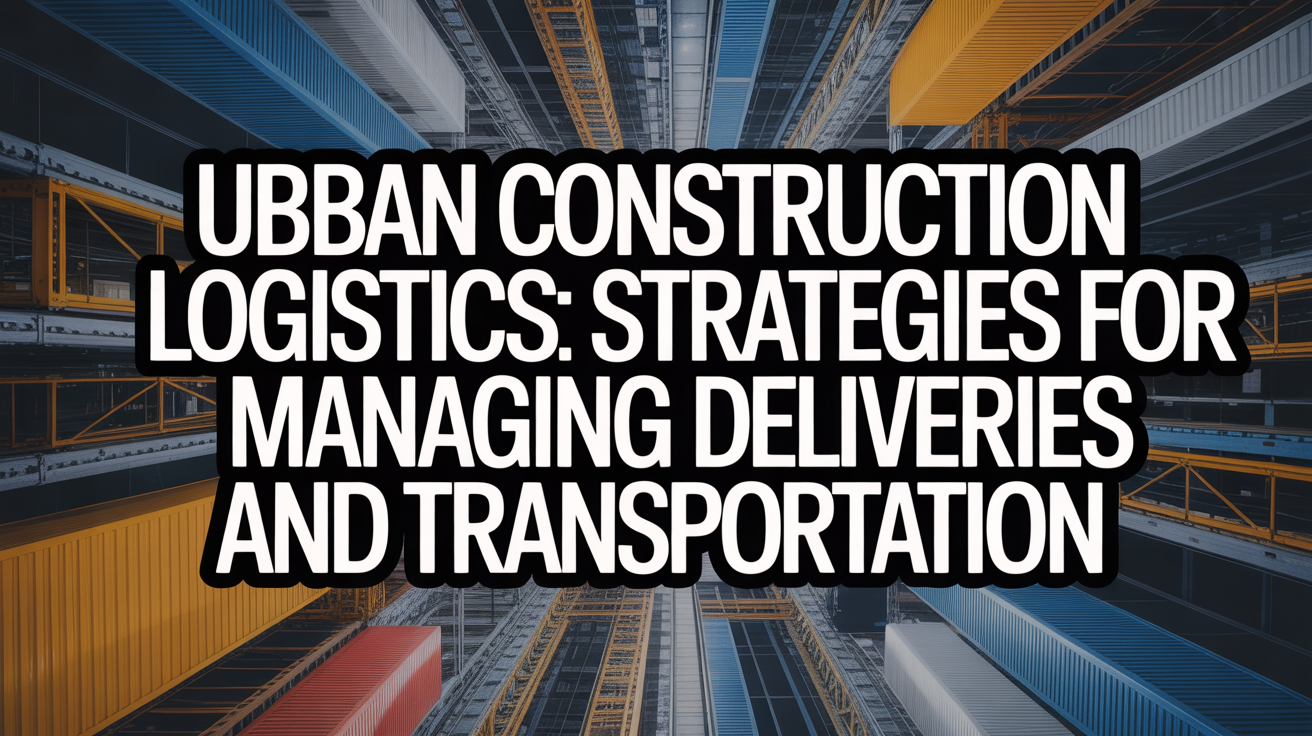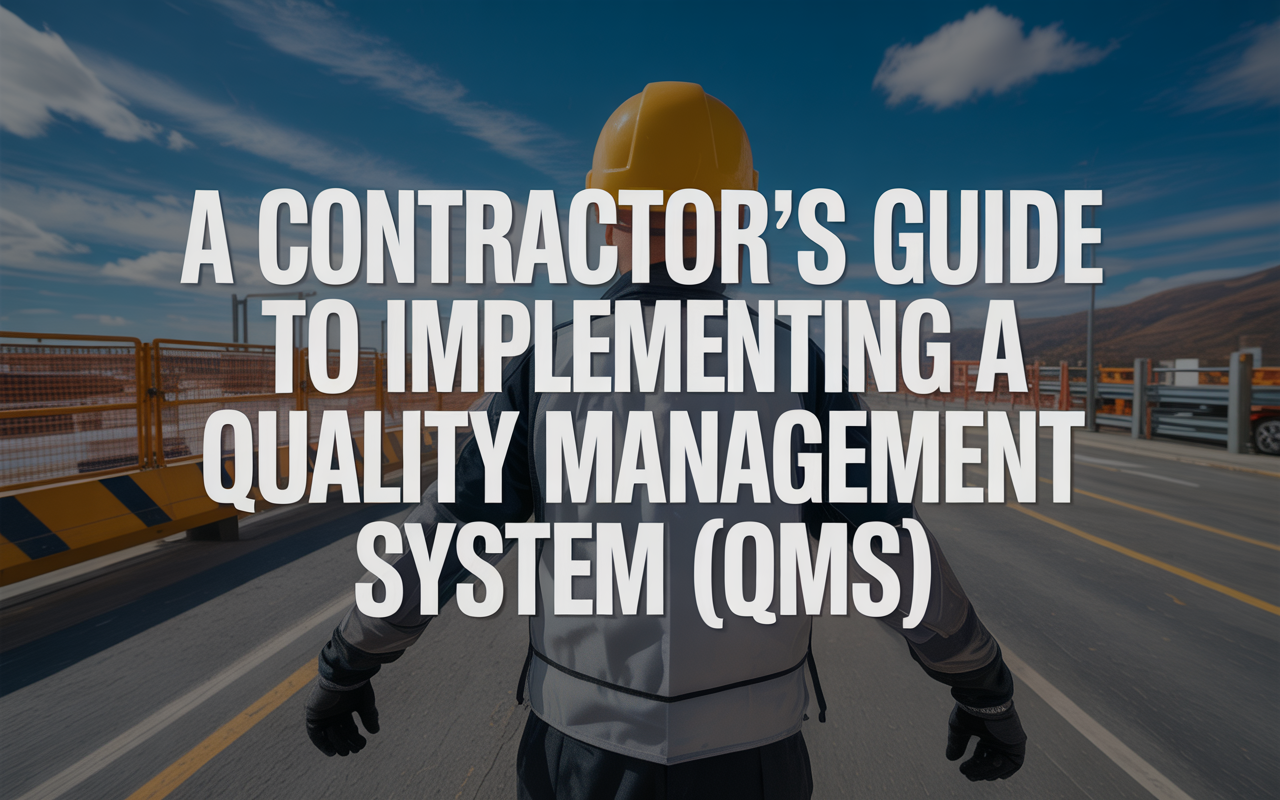Running a fleet isn’t just about getting from A to B anymore. Skyrocketing fuel prices ⛽ and the ever-present risk of accidents put immense pressure on logistics operations. We’re talking significant costs that can eat into profits if not managed properly. Thankfully, technology isn’t just sitting on the sidelines; it’s actively stepping in to help businesses gain control.
Fleet management technology offers a powerful toolkit to tackle efficiency woes, bolster safety protocols, and keep costs in check. It’s about working smarter, not just harder. By leveraging data and automation, companies can transform their fleet operations from a major expense center into a streamlined, high-performing asset.
This is where innovative providers like Nektar.io come into play. They understand the complex demands of modern logistics and offer integrated platforms designed to bring all the benefits of fleet technology together, making sophisticated management accessible and effective for fleets of all sizes.
What Fleet Management Technology Does
So, what exactly *is* this tech we’re talking about? Think of it as a central nervous system for your vehicles and drivers. It typically combines GPS tracking, telematics (collecting data from vehicles), and workflow automation software. These components work together to give managers a bird’s-eye view and granular control over their entire operation.
It’s about more than just knowing where your trucks are.
As Cprime puts it, fleet management systems allow you to “manage, control, analyze, and optimize tasks related to company vehicles through integrated features such as route optimization, driver monitoring, fuel management, and vehicle maintenance scheduling” (Cprime).
It’s a comprehensive approach to making your fleet run like a well-oiled machine. ⚙️
Core Features Driving Operational Efficiency
Let’s break down some key features that make a real difference:
GPS Tracking and Route Optimization
Knowing where your vehicles are in real-time is fundamental. But smart systems go further, analyzing traffic patterns and suggesting the most efficient routes. This isn’t just about saving time; it directly cuts down on fuel consumption and vehicle wear.
As CalAmp notes, sophisticated systems analyze historical and real-time traffic data to avoid bottlenecks (CalAmp)
, getting your drivers where they need to be faster and cheaper.
Automated Maintenance Scheduling
Unexpected breakdowns are a nightmare – costly repairs, missed deliveries, unhappy customers. Fleet technology helps prevent this. Systems monitor vehicle diagnostics and mileage, triggering alerts for scheduled maintenance *before* a minor issue becomes a major failure.
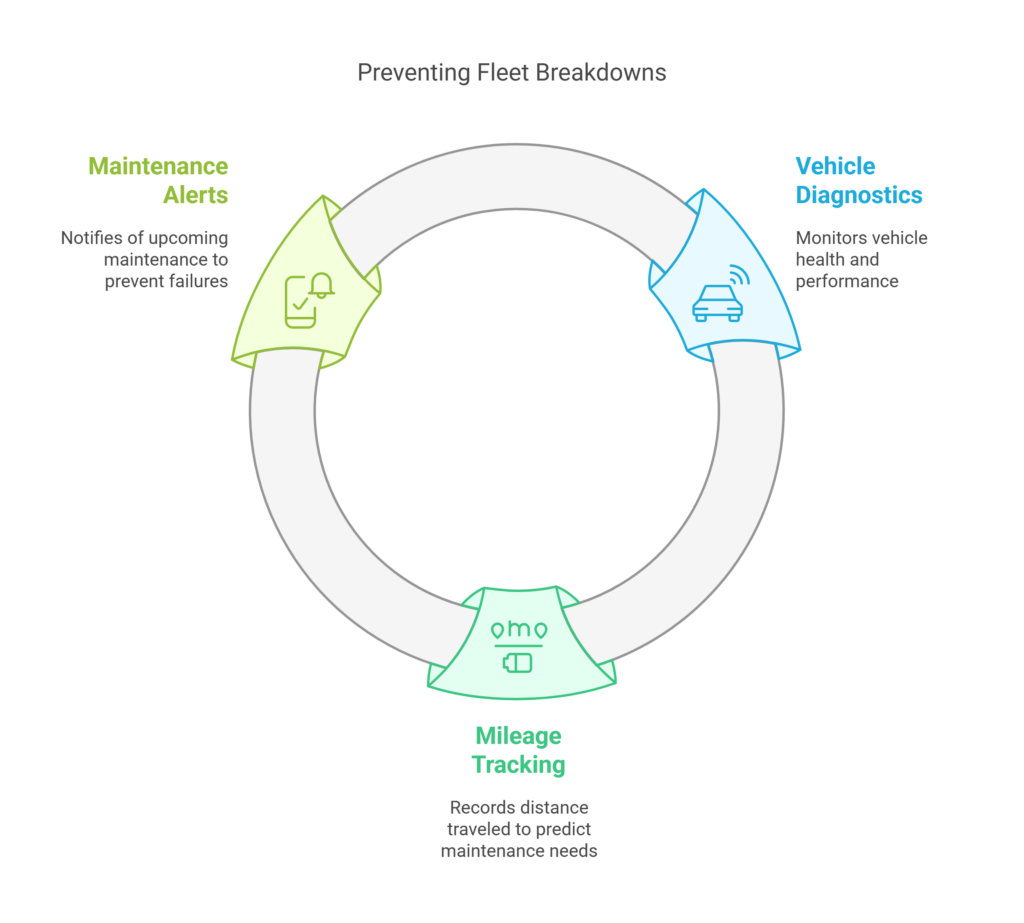
Fleetio highlights this, stating, “Telematics systems enable predictive maintenance by analyzing vehicle data to anticipate potential issues” (Fleetio).
Stay ahead of repairs and keep your vehicles reliably on the road.
Driver Behavior Monitoring
Safety and efficiency often go hand-in-hand. Technology can monitor driving habits like speeding, harsh braking, sharp cornering, and excessive idling. Getting alerts on risky behavior allows managers to intervene with coaching or training, promoting safer driving habits.
As PCS Soft emphasizes, “Monitoring driver behavior not only reduces the risk of accidents but also helps ensure compliance with safety regulations” (PCS Soft).
This protects your drivers, your assets, and your reputation. 👍
The Financial Impact of Implementation
Let’s talk money 💰. Implementing fleet management tech isn’t just an operational upgrade; it’s a financial strategy. Smarter routing and reduced idling directly lower fuel bills – often one of the largest operating expenses. Predictive maintenance cuts down on expensive emergency repairs and costly downtime.
Beyond fuel and maintenance, optimized routes mean less unnecessary overtime for drivers. Plus, GPS tracking acts as a significant deterrent against vehicle theft or unauthorized use.
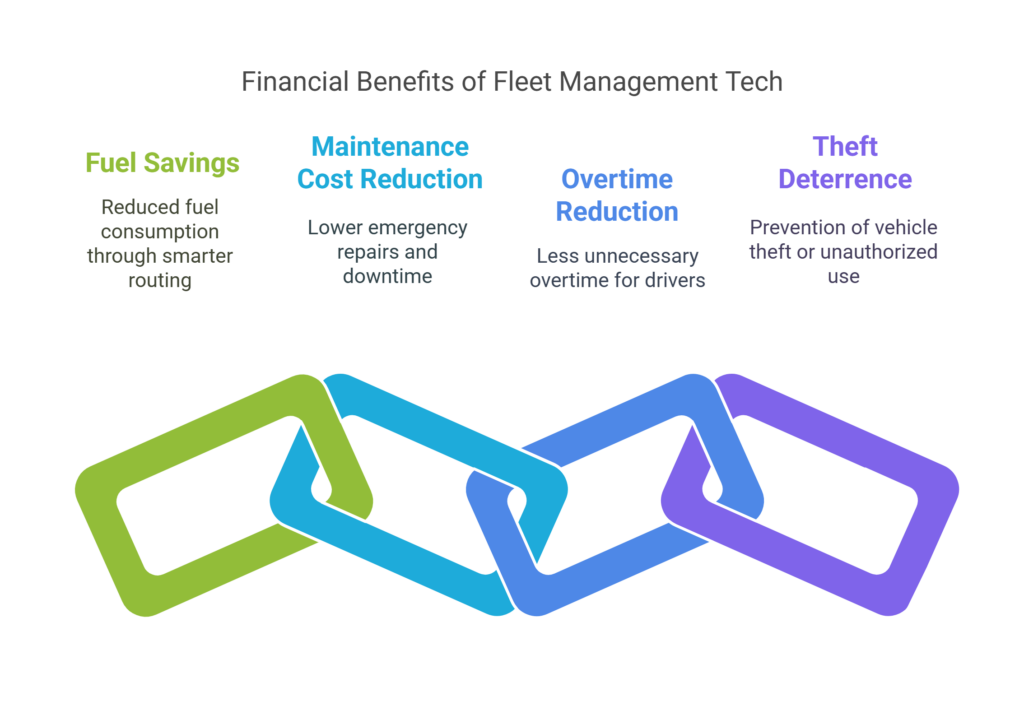
AtoB points out that route optimization isn’t just convenient, it “can save businesses significant time and fuel through data-driven insights” (AtoB).
These savings add up quickly, often delivering a strong return on the initial investment.
Safety Enhancements Through Technology
The safety benefits are profound. Real-time alerts for things like harsh braking or speeding allow for immediate driver feedback or intervention. Some systems even provide safety scores based on driving patterns, encouraging smoother, more defensive driving across the fleet.
This proactive approach significantly reduces the likelihood of accidents. Safer driving means fewer insurance claims, lower repair costs, and most importantly, protecting your drivers and the public.
TruckLabs rightly observes, “Monitoring driver behaviors like speeding or harsh braking encourages good habits and enhances overall road safety” (TruckLabs).
It’s about building a culture of safety backed by data. 🙏
Customer Satisfaction Improvements
Happy customers are repeat customers. Fleet technology plays a vital role here too. Accurate GPS tracking allows you to provide precise Estimated Times of Arrival (ETAs) and even share real-time tracking links. This transparency manages expectations and drastically improves the customer experience.
As Fleetio points out, “FMSs lead to better customer experiences through reduced delays and improved communication” (Fleetio).
No more vague delivery windows! 😊
Data-Driven Decision Making
Gut feelings have their place, but managing a modern fleet requires data. These systems collect vast amounts of information on fuel usage, route efficiency, driver performance, vehicle health, and more. This isn’t just raw data; it’s processed into actionable insights through automated data collection.
Managers can easily spot trends, identify areas for improvement, and make strategic decisions based on solid evidence. Need to decide which vehicles are most cost-effective or which routes need optimization? The data holds the answers.
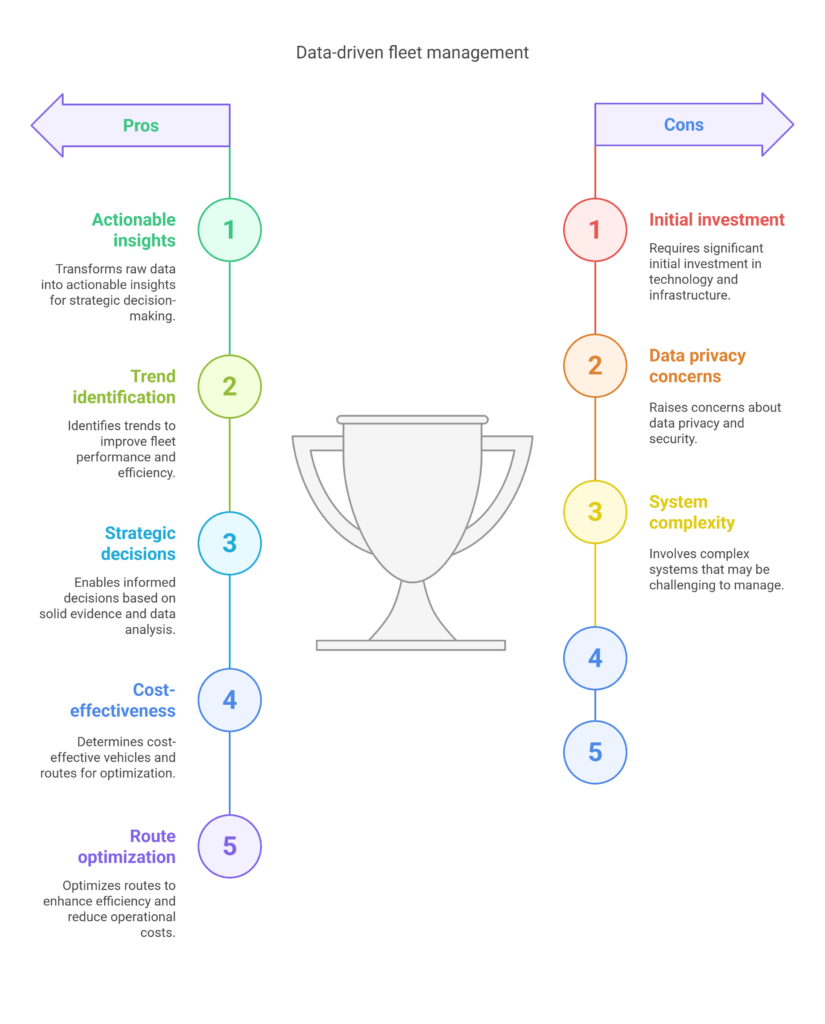
Coast Pay sums it up well: “The valuable data collection capabilities enable trend identification, performance analysis, and ultimately, better strategic decisions” (Coast Pay).
📊
How Nektar.io Integrates These Solutions
Bringing all these powerful features together seamlessly is crucial. That’s where platforms like Nektar.io shine. They don’t just offer individual tools; they provide an integrated platform where real-time tracking, automated maintenance alerts, driver behavior monitoring, and route optimization work in concert.
Think about the difference: Standard approaches might give you GPS data here, maintenance reminders there, and fuel reports somewhere else. Nektar.io aims to unify this. Their platform focuses on customizable workflows, turning raw data into automated actions – like triggering a maintenance check based on a diagnostic code or alerting a manager to repeated speeding incidents. They combine sophisticated real-time tracking with predictive analytics to give you a complete picture.
Instead of juggling multiple systems, Nektar.io offers a cohesive dashboard where you can see everything at once, making management simpler and more effective. They focus on configuring the platform to match *your* specific operational needs, ensuring you get the most relevant insights and control mechanisms for your unique fleet challenges. It’s about making advanced technology practical and results-oriented.
Common Concerns About Implementation
Adopting new technology can feel like a big step. Some common worries include the initial cost, the time needed for training staff, and data security. These are valid points, but often, the benefits quickly outweigh the concerns.
Yes, there’s an upfront investment, but
as PCS Soft suggests, the “upfront costs often yield a quick return on investment (ROI) through substantial operational savings” in areas like fuel and maintenance (PCS Soft).
The efficiency gains start paying dividends almost immediately. Modern systems are also becoming increasingly user-friendly, minimizing extensive training requirements.
Data security is paramount, especially with location and vehicle information. Reputable providers like Nektar.io use robust, enterprise-grade encryption and security protocols to protect your sensitive data, ensuring compliance and peace of mind. Choosing the right partner addresses these concerns head-on. 🔒
FAQs
- What’s the primary benefit of fleet technology?
It significantly reduces operating costs, mainly through better fuel optimization strategies and proactive vehicle maintenance scheduling, cutting down on expensive surprises. - How does it improve driver safety?
By monitoring driving habits like speeding, harsh braking, and excessive idling through telematics data, it allows for targeted coaching and promotes safer behaviors on the road. - Can small fleets benefit?
Absolutely! Even fleets with just 5-10 vehicles can see tangible benefits like reduced administrative workload, lower fuel expenses, and improved vehicle longevity. Scalability is key. - What’s the implementation timeline?
It varies, but many systems can be up and running within 2-4 weeks, including hardware installation (if needed) and basic user training. Good planning makes it smoother. - How does it handle data security?
Top providers employ enterprise-grade encryption for all transmitted data (GPS location, driver behavior, vehicle diagnostics) and secure cloud storage, adhering to strict privacy standards.
Conclusion
The challenges facing fleet managers today – from volatile fuel costs and safety risks to increasing customer demands for transparency – are real. Fleet management technology isn’t just a ‘nice-to-have’; it’s becoming an essential component for competitive and efficient operations. It provides the visibility, control, and data insights needed to navigate these complexities successfully.
By embracing tools for route optimization, predictive maintenance, driver monitoring, and data analysis, businesses can unlock significant cost savings, improve safety records, and deliver better service. Partnering with a provider like Nektar.io ensures you get a solution that integrates seamlessly and is configured to meet your fleet’s specific goals. Ready to steer your fleet towards greater efficiency? 🚀
Key Takeaways:
- GPS tracking and smart route optimization can potentially cut fuel consumption by 15-20%.
- Predictive maintenance alerts drastically reduce unexpected vehicle downtime and repair costs.
- Monitoring driver behavior demonstrably decreases accident rates and associated expenses.
- Centralized data provides clear insights for faster, more effective decision-making.
Call to Action: Take control of your fleet’s performance. Explore Nektar.io’s comprehensive fleet management solutions and ask about a free operational efficiency audit to see how technology can transform your logistics. ✨


